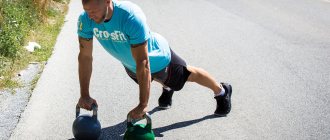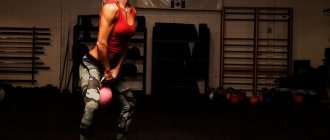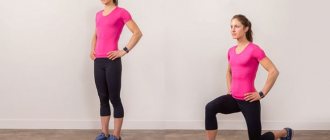The muscle corset is a complex of tissues that regulate the functioning of the pelvic region and the spinal column. The corset also consists of additional supporting elements: films and tendons. The muscle corset must be strengthened regularly.
Exercises to strengthen the muscle corset improve posture, strengthen the spine, and increase endurance. The entire musculoskeletal system becomes more resilient. With regular training, a person feels a surge of strength and energy, mood improves, and overall well-being improves.
Components of a muscle corset
Certain muscle groups need regular training to make them stronger and more resilient.
Muscle corset
The muscle corset consists of the following elements:
- The transverse muscle group that surrounds the body and is located in the abdominal region. Supports internal organs in their natural, physiological position, participates in the process of retraction and relaxation of the abdomen.
- Pelvic muscles, which include fascia, ligaments, and muscles.
- Fascia in the thoracolumbar region. These are connective tissues that are located between the pelvic region and the spinal column. They stabilize the spine and serve as its support.
- Multifidus muscles, which are localized in the posterior part of the spinal column. The spinal discs are fixed and the load is evenly distributed across each vertebra.
- The diaphragm is the area that regulates respiratory processes. Restores thoracic and abdominal pressure, stabilizes the spinal column and chest.
Lack of physical activity is fraught with loss of elasticity and performance of the muscle corset. This is accompanied by a feeling of pain and impaired mobility. The progression of osteochondrosis, hernias, arthritis, scoliosis begins, and the physiological location of the internal organs changes.
Early period
The first 14 days after spinal surgery are called the early period. It is characterized by:
- healing of the surgical suture;
- restoration of sensitivity of the limbs;
- reduction in pain intensity.
The patient is prescribed to wear a special corset, which is recommended to be used during other periods of rehabilitation. It limits sudden movements, keeps the vertebrae in a stable state, and prevents their displacement. The patient is also prescribed medications (NSAIDs, painkillers, sedatives) and exercise therapy.
Gymnastics are performed carefully, in the presence of an instructor. Later, the neurologist examines the patient, determines the sensitivity of the limbs, and prescribes an MRI. Based on its results, the issue of moving to the next stage of recovery is decided.
How to check the muscle corset
To check the muscle corset, several basic tests are used:
- To check the stabilization of the spinal column, a person gets on all fours and rests his hands on the floor. It is necessary to keep your back and knees at right angles. Extend your left arm forward and right leg back, keeping it straight. Stretch your neck, point your head forward. Impaired balance indicates destabilization and weakness of muscle tissue.
- A person lies on his back on a hard surface, lifts his limbs up. The stomach is pulled in, the core muscles are tense. The chest begins to rise with an arched back. You must hold this position for at least 60 seconds. If less time has passed, then the muscle tissue needs to be worked out.
The condition of the muscle corset depends on the degree of mobility, a person’s lifestyle, and body weight. In addition to physical activity, it is necessary to adjust the diet and introduce a sufficient amount of nutrients into it: protein, fats, vitamins, minerals.
Goals and objectives of rehabilitation after spinal surgery
After the operation, the patient feels better, as severe pain disappears, but before complete recovery, he needs to go through a long rehabilitation path. Its duration varies from month to year, depending on the complexity of the surgical procedure. This period requires the patient to carefully and systematically follow all the doctor’s instructions. Only thanks to this tandem will the prognosis of the disease be positive and the risk of relapse will sharply decrease. Rehabilitation involves performing the following tasks:
- stabilization of the patient's condition;
- remove mobility restrictions;
- restoration of normal functioning of the spine;
- complete elimination of the inflammatory process and pain in the spinal column;
- lifting restrictions on physical activity.
The goal of rehabilitation is to restore motor function after spinal surgery, completely relieve pain, strengthen the back muscles and prevent relapses of the disease. In the first period after surgery, the patient is prescribed bed rest. Its duration depends on the type of surgery and ranges from 3 to 7 days.
A longer restriction of movement (up to 2 months) is prescribed after spondylolisthesis, surgery to restore displaced vertebrae. After the manipulation, the patient is put on a plaster corset, which is eventually replaced with a removable splint-leather corset. The entire rehabilitation period, the patient lies on a specially equipped bed.
After surgery to correct scoliosis, the patient is transferred to the intensive care ward and only on the third day - to the usual one. In the first two weeks, the patient is prescribed strict bed rest, and after this period, he is allowed to walk a little. For the entire rehabilitation period, he is prescribed to wear a corset that limits movement, walk, and gradually increase the distance.
The most effective exercises to support the muscular corset
The spinal column includes movable elements - vertebrae with discs that absorb shock. The vertebrae and intervertebral discs are the basis that provides balanced curves and mobility of the spine. A healthy back means elastic, flexible discs and good condition of muscle tissue.
To support their health, it is recommended to regularly perform a set of specially designed exercises. They are classified into several main groups:
- stretching exercises - for slow, static stretching of muscles;
- strength training - systematic repetitions of contraction of muscle tissue, until they are completely tired;
- performing aerobic exercises that involve large areas of muscle tissue.
At the initial stages of training, it is recommended to conduct it under the supervision of an experienced, qualified instructor. A specialist will help you choose an individual set of exercises and hone the correct technique for performing them. In the future, you can study on your own. The workout takes place at a comfortable pace, without wear and tear. There should be no pain or discomfort.
Strength training
Strength loads quickly strengthen muscle tissue, increasing their tone, and increasing endurance. Harmonious development of the back muscles and abs helps maintain an even posture.
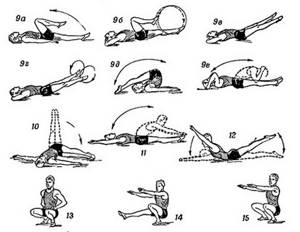
Exercises that develop strength and endurance
The following exercises are recommended:
- Upper abs crunches. The person takes a horizontal position on a flat, hard surface (the floor), puts his arms along his body, and bends his legs at the knees. To eliminate the arch in the back, you need to press your pelvis tightly, then you need to lift your shoulder blades off the floor and hold in this position for up to 15 seconds. Repeat at least 5 times.
- Twisting the oblique muscles. You need to lie on the floor, raise your head and move your shoulder towards the opposite hip, stretching your arms forward. Hold for 15 seconds. Repeat 5-15 times in each direction.
- “Superman” - alternate lifts of the body to the left and right. You need to lie face down on the floor, place your arms along your body. Tighten your gluteal muscles, raise your head and stay in this position for up to 15 seconds. Repeat several times.
- Swing your arms and legs. You need to lie on the floor with a rolled cloth under your forehead. The arms are extended above the head; a small pillow can be placed under the pelvic area and stomach. Keeping your left leg straight, raise it a few centimeters from the floor, while simultaneously raising your right arm straight. Hold this position for up to 10 seconds. Repeat for the other side. Do 5-15 repetitions.
The exercises can be performed one at a time or included in your daily workouts all at once. The load should be feasible and moderate.
Stretching exercises
Stretching exercises help increase the flexibility of the intervertebral tissues and pelvic area. This prevents abrasion of the articular surfaces and traumatic injuries during training.
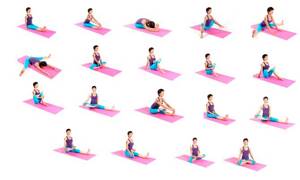
Stretching exercises
These exercises are recommended to be performed after intense training to prevent pain and overstrain of muscle tissue:
- Stand up straight, arms along your body. Bend back, arching your back. Maintain balance and stay in this position for up to 10 seconds. There should be no pain or discomfort. Repeat up to 7-15 times.
- Lie on your back, place your arms along your body. Pull your knees towards your chest until you feel a stretch in the lumbar region. Freeze in this position for 10 seconds. Do several approaches.
- Lie on your back, bend your knees. Raise 1 leg up, holding the back of the thigh. Try to straighten your leg and hold in this position for 10 seconds. Repeat for the other leg.
The described exercises are performed slowly, avoiding pain. It is necessary to stretch as much as individual training allows.
Aerobic exercise
During aerobic training, muscle tissue uses the energy generated by breaking down sugars with oxygen (aerobic glycolysis). Aerobic exercise involves a large number of muscles, putting stress on the heart and blood vessels. They are also called “cardio training”. The load on the joints is reduced, and movements are cyclical. Such exercises strengthen the back muscles, have a beneficial effect on the state of the cardiovascular system, respiratory organs, and increase endurance. The following sports are recommended as aerobic exercise:
- cycling;
- running;
- rowing;
- dancing;
- walking.
You can train several times a week. Walking at a fast pace in the fresh air is recommended daily: at least 10,000 steps. To determine the intensity of your exercise, it is important to monitor your heart rate. There is a formula for determining the maximum heart rate: 220 - a person’s age. Your heart rate should remain between 55-65% of your maximum heart rate.
Thanks to regular training, energy potential increases, mood improves, metabolic processes are restored, and excess fat is burned.
Many athletes note that performing aerobic exercises before strength training enhances the effect of burning fat and prevents overwork of certain muscle groups. It is important to avoid general fatigue and exhaustion.
To keep your back healthy and your posture straight and beautiful, it is recommended to exercise regularly, without skipping, choosing the most suitable, comfortable set of exercises for yourself.
General exercises to strengthen the muscle corset
Below is a mix of exercises that you can do daily to complement your regular exercise.
They are easy to implement and suitable even for beginners:
- The plank can be performed at any time of the day; it is a simple and effective exercise. Body position as in push-ups. Push off the floor with your elbows and forearms. Bring your feet together, tense all muscle groups, pull in your stomach. Hold this position for 20 seconds to 2-3 minutes.
- The previous exercises can be supplemented by raising the straight leg up, above the shoulder line. The technique is similar. You can also move your legs to the side to enhance the effect.
- To strengthen the muscle corset and buttocks, walking on the buttocks is recommended. Starting position: sitting on the floor with your back straight. The abdominal muscles are tense. Slowly begin to “walk” your buttocks along the floor, covering at least 1.5 m in one approach. It is important to ensure that your back is straight.
- Exercises on an unstable platform strengthen the core muscles and abs. To perform them, you can use any swinging board. It is necessary to maintain balance. This activates the back, hips, and stomach.
Each of the exercises increases the strength and endurance of the muscular frame, forcing it to function at full strength.
So what do you need to remember?
- Monitor your well-being. There should be no discomfort or (especially) pain in problem areas of the spine - their appearance may indicate a worsening of the condition. Only slight inconveniences that do not hinder movement are acceptable.
- The exercises are performed as carefully as possible. It is important to ensure that weakened muscles are strengthened, and hardened muscles gradually relax.
- Exercises that involve various types of “twisting” should be avoided. You should also avoid jumping, sharp jolts and blows in the back, and serious efforts on problem areas of the spine.
- When and how much? A set of 2-4 sessions is divided into a series of exercises performed 5-6 times a day in certain portions.
- We don’t jump right off the bat! We start calmly - with a minimum of loads and low amplitudes. Next, as your general well-being improves, we carefully increase the pace.
- Prepare for the fact that you will have to perform the exercises on an ongoing basis for preventive purposes.
- If there is an exacerbation of diseases of the musculoskeletal system, you cannot exercise - exercises should be postponed until the inflammation subsides.
- The main emphasis is on the quality of exercises. Don't chase quantity! Without much strain or severe shortness of breath, you can perform them in 1-2 sets at a calm pace of 15 exercises. Do them smoothly, without jerking.
Restrictive measures
The principles of rehabilitation include not only tips for restoring health, but also prohibitions. The patient must not:
- sit;
- stay in one position for a long time;
- lift weights more than 3 kg;
- wear a corset for a long time (more than 3 hours);
- physical exercise;
- conducting manual therapy;
- perform twisting movements.
For the first month and a half, the patient should not sit down; sudden movements should be avoided. For 3 months it is prohibited to ride in public transport while sitting. You need to take a semi-lying position and wear a corset. When carrying weight, distribute it on both hands or put the load in a backpack.



